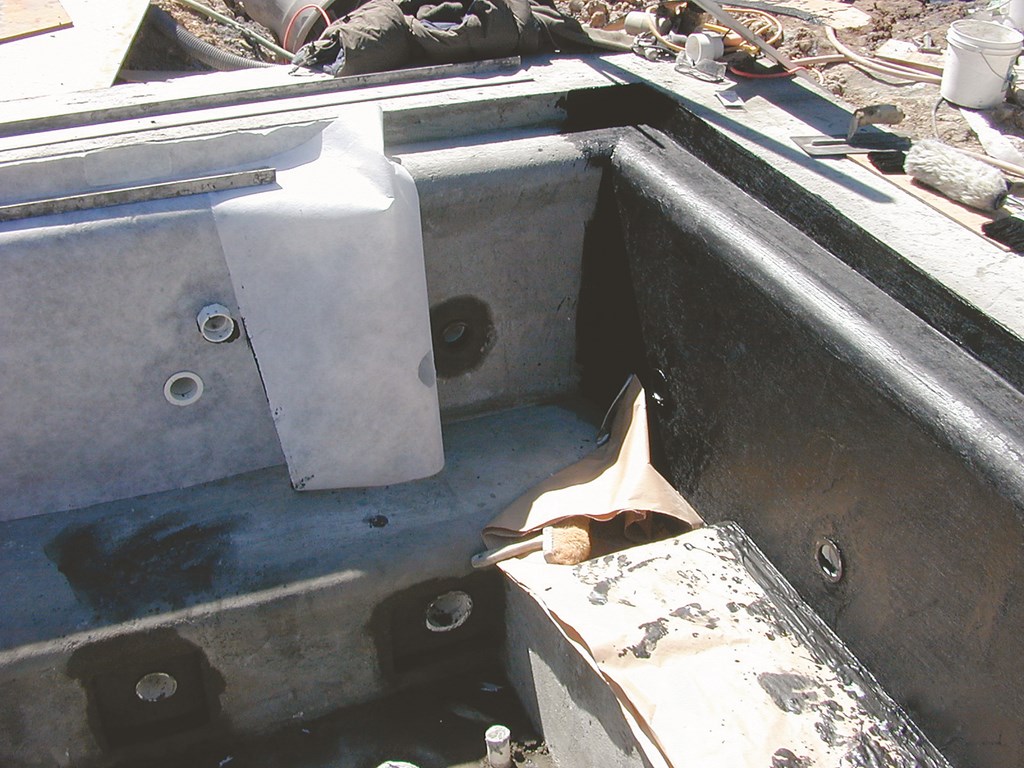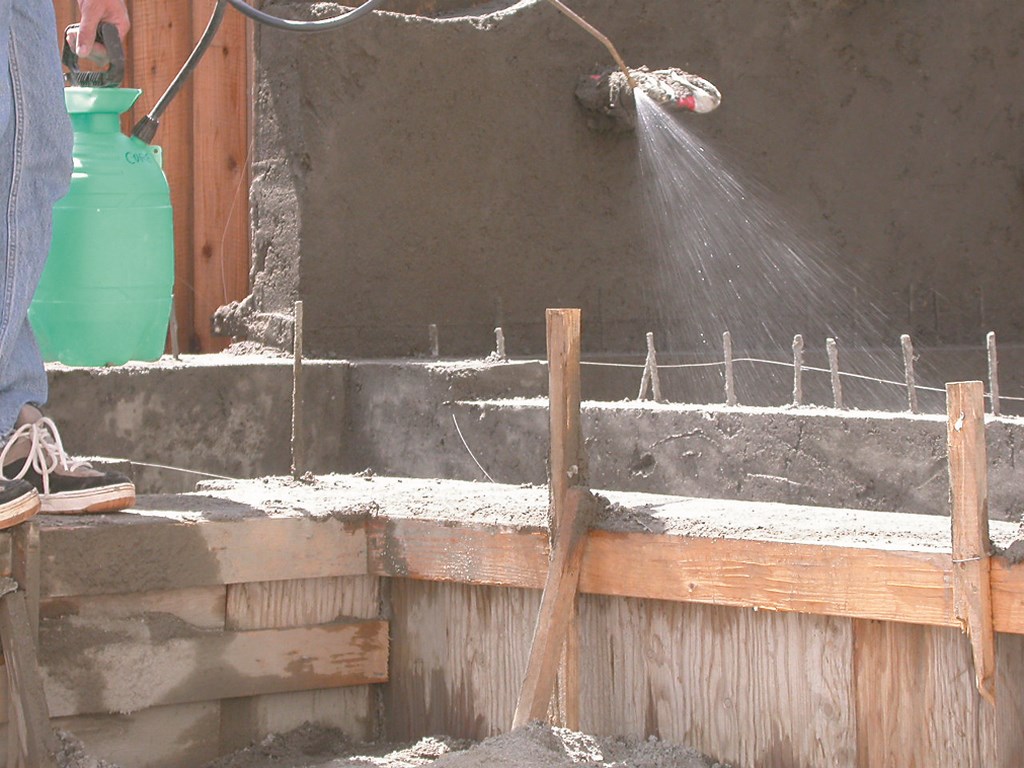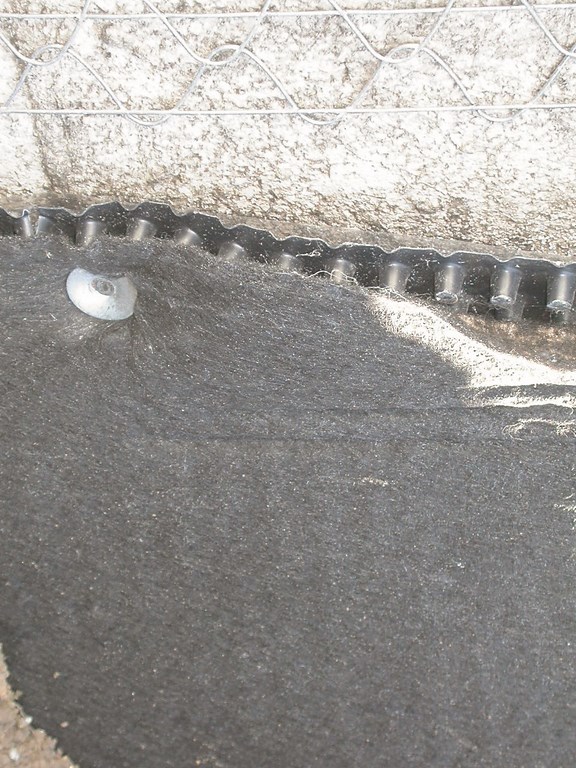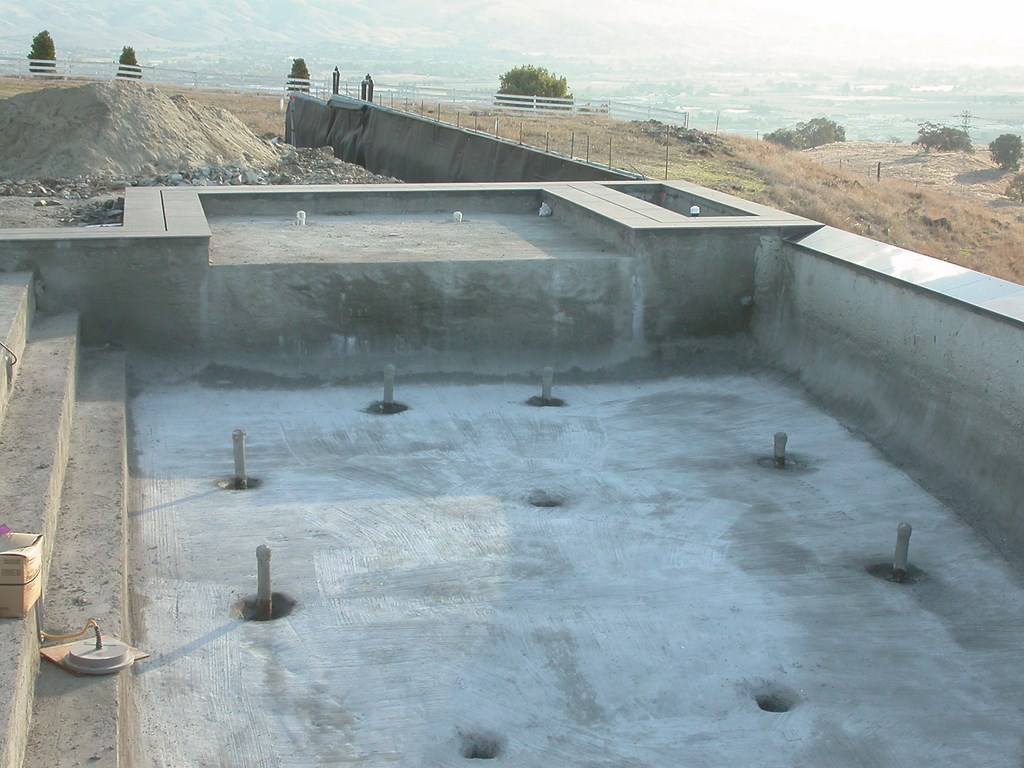Protective Measures
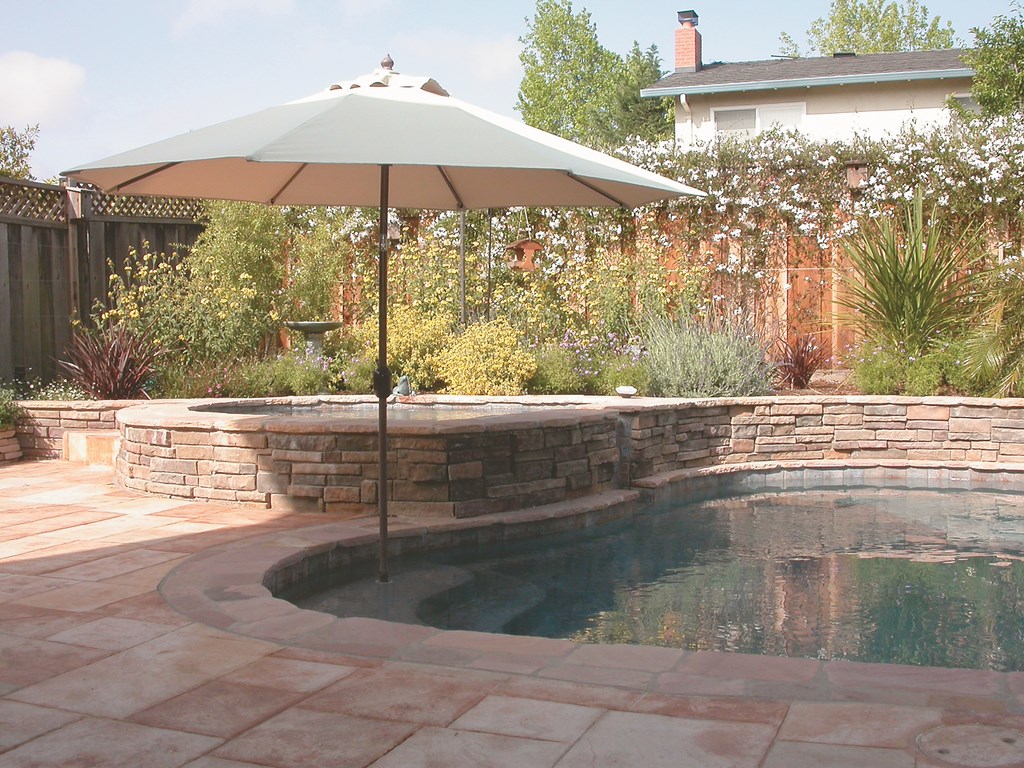
Next to the water itself, concrete is the most important and widespread of materials used in watershaping. Not only is it instrumental in creating the structures that contain water as well as the substructures that support them, concrete is also the stuff of which faux-rock panels, pre-cast or poured-in-place coping, pavers, all manner of stamped or textured decks and poured-in-place or block walls are made.
Despite its omnipresence, however, concrete remains one of the most misunderstood of all watershaping materials in this sense: Because it is so durable in basic structural applications, there’s a tendency to presume that same durability extends to exposed concrete surfaces. In other words, once it is poured and troweled to the desired finish, most people have the notion that concrete does not require any ongoing maintenance. This is, however, yards from the truth.
In fact, concrete is just as susceptible to the ravages of heat, water intrusion, freeze/thaw cycles, staining and erosion as are stone-veneered decks, so it is just as important to take steps to protect these surfaces against such damaging influences. And the benefits of “fortifying” concrete run more than skin deep: Sealing concrete to prevent water intrusion not only prolongs the life of the structure, it also protects the internal reinforcing steel from corrosion.
CATEGORICAL RESISTANCE
Many products can be put into service to waterproof and otherwise protect concrete. In sorting through the available materials, I find it helpful to divide them into five basic (and occasionally overlapping) categories: integral admixtures, curing agents, sealers, densifiers and surface coatings.
Each class of products has its distinct functions, while each individual product has its own set of performance features and advantages. As a result, familiarity with the full range of product characteristics and capabilities is needed to match the right material to the appropriate application. You also need to factor in cost: Some of these products are outrageously expensive – so much so that they can become factors in planning and design decisions.
At whatever cost, however, I use protective products to enhance the performance and lifespan of my company’s work and see both the cost and the labor as matters of working toward a higher standard of quality. It’s also something we talk about with our clients by way of helping them appreciate the importance of protecting the investment they’ve made in their beautiful backyards.
As you’ll see below, no single product suits all needs. In fact, depending upon the situation (and as is highlighted in the first sidebar below), you may end up using combinations of products to maximize the long-term performance of your work.
[ ] Integral Admixtures: Most protectants are used on concrete after it has been applied, but admixtures go into the batch at the mixing stage.
In fact, admixtures must be specified when the concrete is ordered so they can “become one” with the concrete and be present throughout the structure. This is especially valuable in situations where you don’t have access to the back side of the concrete after placement – as with pool and fountain shells, shotcrete walls against hillsides and most decks, for example.
Most admixtures are intended to maintain structural integrity and extend the lifespan of reinforcing steel by preventing the corrosive “wicking” of water into the concrete. This is a particular plus when you work in areas with high ground water – including coastal regions, where the effects of water intrusion can be catastrophic.
| For many of our jobs, we use an old-fashioned gunite rig that lets us put admixtures (such as fly ash, waterproofers, set retarders and more) directly into the mix while monitoring each batch. In the inset photograph, for example, we’re adding an integral waterproofer to the gunite mix in proportions recommended by the admixture’s manufacturer. |
One of the original and most familiar admixtures is fly ash. With its ultra-fine particle size, fly ash acts as a pozzolan, meaning it makes the concrete denser and thereby less porous. Fly ash is still used by batch-concrete plants to increase the psi of cured concrete and is commonly specified in mix-design standards.
Other admixtures work in that same way, filling the capillaries within the concrete matrix as a way to prevent the intrusion of water. Yet many of these materials take a further step by allowing smaller air molecules to pass through: These products, said to be “hydroscopic” in the presence of water, crystallize and grow throughout the batch in a chemical reaction with the initial mix water. Once the hydration process is complete and the water has evaporated, crystal growth ceases – but begins again if water is introduced, thereby stopping wicking or weeping on an ongoing basis.
| In some cases, multiple systems with the same purpose must be used to achieve desired results. Here, for example, the gunite was mixed with an integral waterproofing agent, but because the spa is to be finished with glass tile, we’re taking the extra precaution of using an additional crack-control membrane/waterproofing system. |
These expansive-crystal products are by far the most expensive of concrete amendments, adding an average of $50 to $100 to a cubic yard of concrete. But for specific applications – in which they serve to ease, for instance, the installation of integrally colored concrete fountains by eliminating the need for an interior finish – the extra cost makes sense. The same holds true for fishponds, surge tanks, raised bond beams, planters and retaining walls.
[ ] Curing Agents: These products are usually applied to freshly poured concrete to retard the evaporation of water. Most contain silicates (often sodium silicate) that aid in the formation of a denser surface and thereby slow the release of water through evaporation. They also usually contain dyes, which helps the applicator see where the product has been sprayed.
In terms of performance, there is some overlap between curing agents and surface sealers (discussed just below), but curing agents serve a specific function cited by the American Concrete Institute (ACI) in recommending their use because they force the concrete to hydrate from the inside and eliminate the need to “water” the concrete, a process that can cause surface discoloration and mottling while increasing the potential for other forms of surface degradation.
We follow ACI’s advice for a simple reason of practicality: Using curing compounds eliminates our reliance on the property owner to wet down the surface subsequent to application, thus guaranteeing proper hydration (and strengthening) of the concrete.
| We apply curing compounds to freshly placed and wetted gunite with a simple sprayer, diluting the compound in water at the level recommended by the supplier. (The steel isn’t stray, by the way: The bars rising above the beam will be used for tying off the poured-in-place coping this spa will eventually receive.) |
We use care in selecting our curing compounds, as some contain whiteners or dyes. The compounds with whiteners are primarily designed for use by municipalities in pouring sidewalks or roadways. They turn the concrete white, which helps retard the effects of the sun and serves as a visual marker of where the compound has been applied.
As an alternative, we use a curing compound that contains a pink, UV-degrading dye on all of our non-colored concrete, stucco and gunite. The pink dye allows the applicator to see where the curing compound has been applied, ensuring even coverage. The color then fades away in a few days.
One big caveat: Do not use curing agents or sealers that contain wax if you are going to be applying any further surface coatings, stucco, stone veneers or plaster. The waxes prevent proper adhesion!
For integrally colored concrete or stamped surfaces, we’ll also use a family of curing agents known as “color cures.” Most pigment manufacturers offer them for use with their products, and we have found that the application of these color-curing compounds on colored concrete has effectively minimized client complaints about color inconsistency. In addition, white “puddle stains” and efflorescence are practically eliminated.
[ ] Sealers: These products are also applied after the concrete, colored concrete or an exposed-aggregate finish has cured and serve as a means of improving appearance, durability and performance.
These products are all primarily used to prevent staining and fall into two categories – penetrating and surface sealers – both of which offer protection against spalling, dusting, efflorescence, freeze/thaw damage, staining and salt damage. Sealers will also deepen colors, enhancing the appearance and lending richness and depth to the surface.
| In this case, waterproofing was accomplished by applying a pale blue elastomeric membrane directly to the inside of a fountain niche (left). Once the pipe perforations were sealed with hydraulic cement, we added a cementitious topcoat (right) as a bonding surface for the ultimate finish. |
When selecting a sealer, look for one that is non-yellowing, contains UV stabilizers and provides superior protection from stains, grease and water penetration. In addition, seek one that can undergo future re-applications without extensive stripping or surface preparation.
Sealers come in two basic formulations: waterborne and solvent-based. As with the stone sealers discussed in the February 2004 issue of WaterShapes (starting on page 42), the solvent-based options for concrete sealing are being phased out of existence because they release pollution in the form of volatile organic solvents (VOCs) as they cure and present safety issues related to inhalation risks and ventilation. Given their toxicity, there’s also a challenge to using solvent-based sealers around plants and grass.
The waterborne options are, accordingly, taking over in the marketplace. They are environmentally friendly, offer easy soap-and-water clean-up and don’t release noxious fumes. Perhaps best of all, the application techniques are more forgiving and allow for quicker turn-around: If a subsequent coat of a solvent-based sealer is applied before the previous coat has fully cured – a period that can often take days – the finish will be subject to clouding or gumming. That’s generally not an issue with quicker-curing waterborne products.
* The penetrating sealers do their work by seeping into the concrete and activating the lime and alkaloids within the cement in a chemical process that causes these unhydrated particles to “gel.” The sprayed-on agents are generally inexpensive (at around $40 per gallon) and are easily applied using a fan-tipped bug sprayer. Once the gel hardens (typically in 60 to 90 days), the capillaries within the concrete are sealed.
Manufacturers of these products say that they can penetrate up to four inches. In going so deep, they displace impurities within the cement and sometimes push them to the surface. For the most part, these impurities are easily brushed away.
Penetrating sealers are extremely useful when working with pre-cast concrete products – that is, those for which you do not control formulation. We use these products on pool and fountain shells, masonry and stucco walls, cultured stone surfaces and glass-fiber-reinforced concrete (GFRC) panels. It is also our practice to spray these sealers on block retaining walls (which might also be filled with an integrally waterproofed grout). Penetrating sealers also work wonders on brown coats to assist in preventing bleed-outs of free lime.
* The surface sealers sit on the surface of the concrete and form a hard shell. As a result, they are generally susceptible to traffic wear and require periodic stripping and reapplication.These sealers are most often used for interior surfaces and lend a welcomed gloss or sheen. Care must be used in applications around watershapes, however, because many of these sealers (especially the semi-gloss varieties) are slippery when wet. Yes, some supplier offer grit additives to combat this shortcoming, but the grit wears away with the surface material and provides no long-term solution to the problem.
| There’s a lot going on here, some of it not so easy to see: On the retaining wall, for starters, you can see the vertical drain mat and, at the far end, a wall section coated with blue elastomeric membrane. (As explained in the sidebar on page 48, the mat will protect the membrane during backfilling and compaction.) The vanishing edge wall has already been coated with the elastomeric membrane and a protective cementitious topcoat in preparation for plastering later on, while the gunite floor is white from the curing compound. All in all, it’s a fairly typical case in which multiple products and materials are used to get the job done. |
Some of the surface sealers can be used on both natural stone and concrete – an advantage we exploit as a means of reducing inventory and training, of gaining consistency in handling and application methods and of minimizing our count of pressure sprayers.
There are also products marketed as concrete waxes. These are designed primarily for indoor use but can also be used outdoors to enhance colors and deepen and enrich surface appearance.
[ ] Densifiers: These products are similar in some respects to sealers in that they are sprayed on material that is already set. They typically contain an active ingredient (often sodium silicate) along with wetting agents that enable the active ingredient to penetrate the concrete surface – also to a depth of as much as four inches.
Densifiers are typically applied after a curing agent is used – usually 30 days later. Once inside the concrete matrix, the active ingredients react with microscopic, unhydrated particles of cement to form a cement gel. Used on cured concrete, concrete block, old concrete, walls and slabs, the product results in a denser surface that resists the migration of water, vapor and even radon gas.
As is the case with penetrating sealers, densifiers have a tendency to push impurities to the surface – a big plus in that these products essentially displace staining material from the inside. While mineral impurities are easily removed, however, grease and oil will require degreasing.
[ ] Surface Coatings: This method of waterproofing and otherwise protecting the surface of concrete involves the application of a coherent, topical membrane. These barriers fall into three primary sub-groups – elastomeric, clay and petroleum-based – and all are applied to the negative side of the wall (that is, to the side from which the water comes).
|
Resources: Manufacturers of products for concrete waterproofing and protection include: Carlisle Coatings & Waterproofing, Wylie, Texas Enduro-Seal USA, Pinehurst, Texas E.P. Henry, Woodbury, N.J. Harris Specialty Chemicals, Shakopee, Minn. L.M. Scofield, Los Angeles Multicoat Corp., Rancho Santa Margarita, Calif. System Dynamics, Scottsdale, Ariz. White Mountain, San Leandro, Calif. Wicktek Inc., Farmington, Pa. Xypex Chemical Corp., Vancouver, BC, Canada — P.B. |
Each of these systems has its own characteristics, but from my perspective the elastomeric coatings have clear advantages.
* As the name implies, elastomeric films have elastic qualities – a big plus in the real world where things sometimes move. If a retaining wall develops a hairline crack, for example, the membrane will stretch across the gap and keep water from migrating through the fracture.
Elastomeric membranes can be brushed, rolled or (my favorite) sprayed on with an airless sprayer. They are water soluble, so cleanup is easy, and they require no special application skills. They do, however, have some drawbacks: They aren’t UV stable, and they’re also susceptible to nicks and tears from rocks of the sort used in backfilling.
To get around that fragility in applications where the membrane is to be used as a substrate for a tile pool, for example, manufacturers offer a cementitious topcoat that provides a bonding surface for brown coats and plaster. We have found that the topcoat on its own is also useful where a shell or wall is to be backfilled and will successfully protect the membrane from tears.
* Surfacing systems that use clay have been available for years and have a proven track record, but they can be cumbersome and installers often have difficulty cutting and fitting the clay-impregnated panels or applying clay emulsions.
The clay panels are applied against the surface to be protected and, as they get wet, the clay expands and seals off any moisture penetration. (Drainage mats, rock backfill and French drains are still required). The emulsions or powders are mixed with water to form a paste that can be applied by brush or roller, but the product has a hard time filling smaller voids and multiple applications are usually required to ensure a complete seal.
* The petroleum-based coatings are similar to roofing tar or driveway sealants and are usually troweled or brushed onto the concrete surface. Once the petroleum solvent evaporates, the membrane stiffens and hardens with time and generally requires no special protection in backfilling. But this hardness becomes a problem in the long haul: If the wall ever develops a hairline crack, the membrane cracks as well.
EVERYTHING YOU CAN
All of this concern about protecting and/or waterproofing one side or the other (or both) of structural or decorative concrete may seem to be overkill, but we look at it this way: It’s a small investment of time and effort that helps both us and our clients avoid the frustration that comes if our work falls prey to any of the visual maladies that can afflict unprotected concrete.
You can’t ever hope to eradicate the ravages of weather, time and usage, of course, but by using various combinations of the products described here, you can significantly increase your concrete’s resistance to forces that can undo the finest work.
Paolo Benedetti is principal at Aquatic Technology Pool & Spa, a design/build firm based in Morgan Hill, Calif. He may be reached at [email protected].














